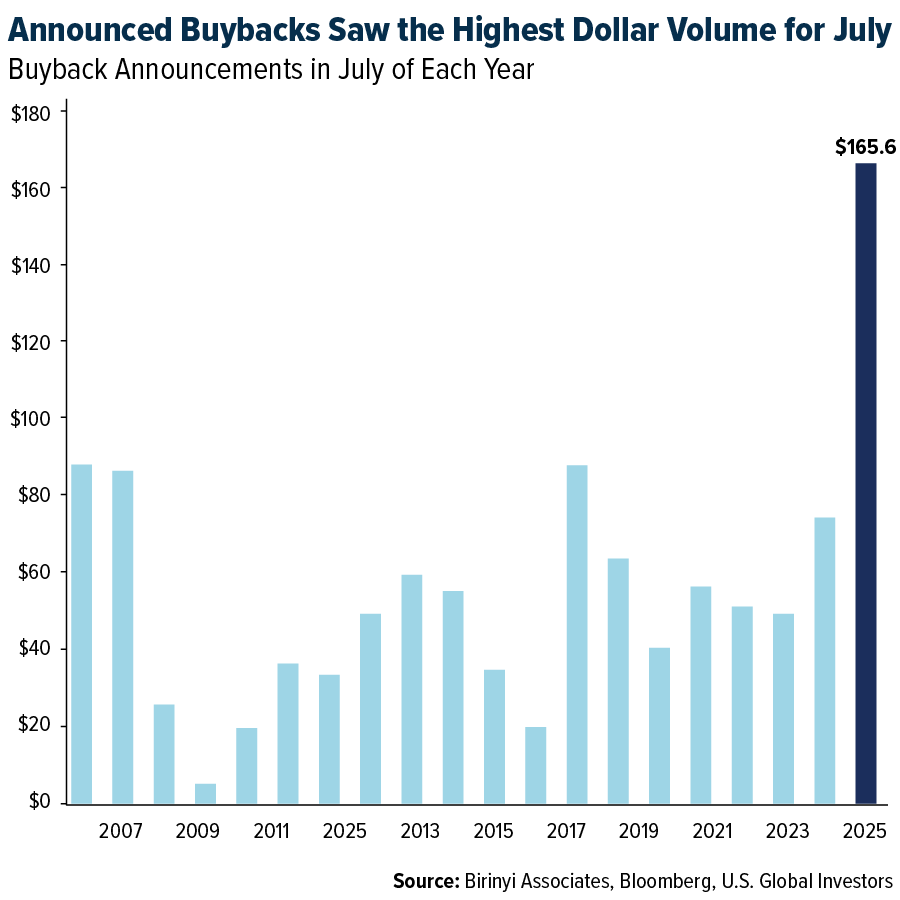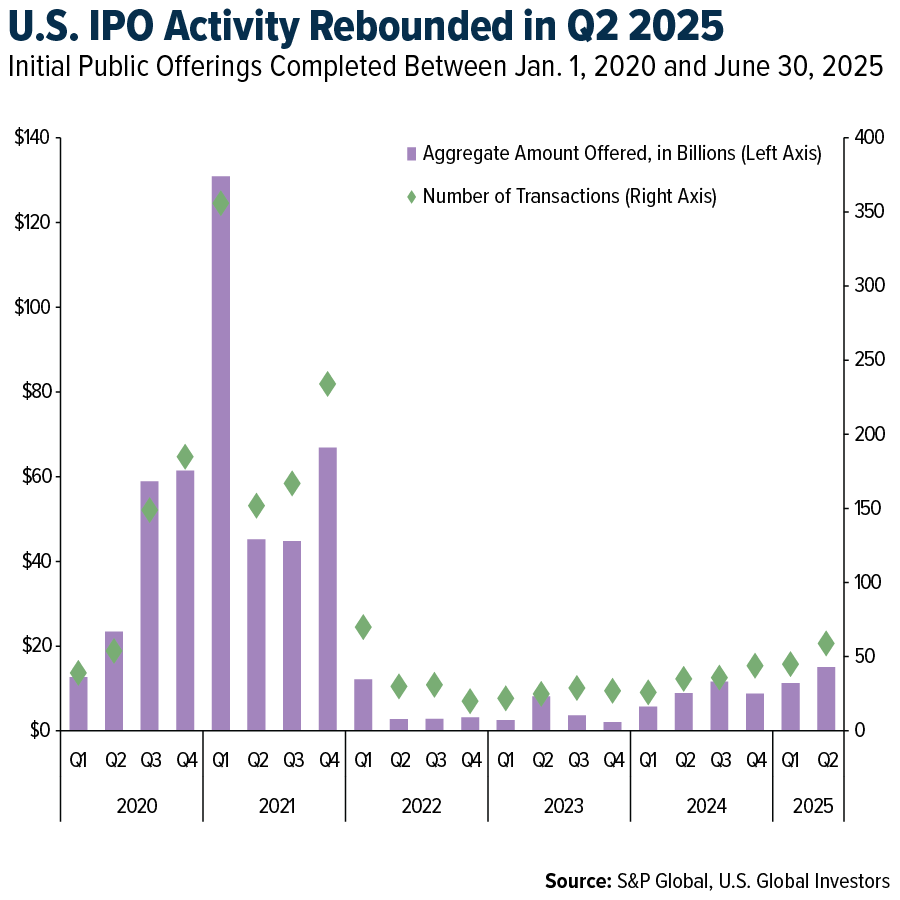Paul Tudor Jones sees potential market rally after late October
“Tariffs are back. The consumer is struggling. August is historically the worst month for stocks.”
You’ve probably seen versions of these headlines this summer. They’re all designed to grab your attention by sounding the alarm, then close with a hand-wringing quote from someone who probably missed the last bull run.
But here’s a rule I live by: Follow the trend lines, not the headlines.
Because if you look past the fearmongering and focus on the data, you’ll find that the market is humming with strength, and investors should take note.
Buybacks Are Booming
Let’s start with stock buybacks. Companies don’t spend money repurchasing shares unless they believe their stock is undervalued or, at the very least, a better use of capital than sitting in the bank.
In July alone, U.S. companies announced a record $166 billion in stock buybacks. That’s the biggest amount recorded in July, more than double the previous record set in 2006.

Year-to-date, buyback announcements total nearly $926 billion, putting us well ahead of the previous record pace. Who’s leading the charge? Financial and tech giants, flush with cash and optimistic that the market will reward them long-term.
Now, some might point out that buybacks peaked earlier this year. That’s true. They’ve come down slightly from Q1 highs, but they’re still running at a historically high level, and that’s what matters.
The IPO Market Is Back
Next, let’s talk about initial public offerings (IPOs). After a few quiet years, the IPO engine looks to be roaring again, a good sign of investor demand.
As of this week, we’ve seen 204 IPOs so far in 2025, up more than 80% from this point last year. Even better, the quality of IPOs is improving. Unlike the SPAC frenzy from 2021, today’s IPOs are rooted in growth and profitability.

The second quarter alone saw $15 billion raised across 59 IPOs, a 34% increase from Q1. With global IPO activity being more mixed, the U.S. is clearly leading the pack.
If markets were truly on the verge of collapse, would we be seeing this kind of investor appetite for new equities? Would billion-dollar startups be going public?
Again, the trend line speaks volumes. Don’t let the media tell you otherwise.
The Smart Money Is Still Investing (in ETFs)
Meanwhile, retail and institutional investors alike are pouring money into ETFs. U.S. ETF assets came close to hitting $12 trillion last month, with $116 billion in inflows alone.
Active ETFs brought in a record $44.8 billion in July, the highest ever recorded. That tells me that more investors are looking for targeted, actively managed exposure to key themes, whether that’s defense, gold, energy or AI.
In fact, active ETFs now make up nearly 10% of the entire ETF market, up from less than 1% just 15 years ago, according to Morningstar.
Strong Earnings, Even Stronger Trends
Want more proof that the market isn’t buying into the doom-and-gloom narrative? Take a look at corporate earnings.
Around two-thirds of S&P 500 companies have reported Q2 earnings, and of those, more than 80% have beaten earnings expectations. That’s not just above the five-year average—it’s the highest beat rate since 2021. In the AI-fueled tech sector, over 90% of companies have posted better-than-expected results.
As for the third quarter, FactSet analysts raised their earnings per share (EPS) estimates, despite the persistent macro headwinds.
Tariffs Are a Drag, But Let’s See How They Play Out
Speaking of headwinds: Tariffs are back, and they’re not insignificant.
The average effective U.S. tariff rate has hit 18.3%, the highest level since the Great Depression. It’s already impacting prices, with economists estimating a 1.8% increase in consumer prices and a potential $2,400 annual hit to the average household, according to Yale’s Budget Lab.
But here’s the thing: Markets have a way of adjusting. Companies shift supply chains. Consumers find substitutes. Tariffs are friction, but I don’t think they have to be fatal.
In fact, some sectors could benefit from reshoring and industrial reinvestment. And let’s not forget that these tariffs were telegraphed well in advance, and markets had time to front-run the changes.
I’m not dismissing the risk. I’m reminding you to watch how markets react, not just how journalists report.
Seasonal Volatility Is Just That—Seasonal
Lastly, a word on seasonality.
Yes, August and September are historically choppy months for stocks. Average returns tend to be weaker, and lower liquidity during the summer means volatility can spike on any bad headline.

The question every long-term investor should ask is: Even if you knew the market would drop 10% next month, would you sell today?
Probably not. Because you’d risk missing the recovery, and you’d likely pay taxes to boot.
Keep in mind that the S&P 500 rose 26% in 2023, and another 25% in 2024. It’s up between 8% and 9% so far in 2025. That’s what long-term compounding looks like.
Trying to avoid every dip and pullback is a fool’s errand. Staying invested—and staying disciplined—beats timing the market almost every time.
Block Out the Noise
It’s easy to feel overwhelmed by negative headlines. That’s their job—to get clicks and sell ads.
As investors, our job is to look at the data, not the drama.
So here’s what the data is saying:
Corporations are confident—just look at buybacks.
Capital markets are thriving—just look at IPOs.
Investors are engaged—just look at ETF flows.
Companies are executing—just look at earnings.
Yes, there are risks. There always are. But the underlying trends, as I see them, show resilience and strength.
So ignore the headlines. Follow the trend lines.
***
All opinions expressed and data provided are subject to change without notice. Some of these opinions may not be appropriate to every investor. By clicking the links above, you will be directed to a third-party website. U.S. Global Investors does not endorse all information supplied by these websites and is not responsible for their content.
